版权所有:内蒙古大学图书馆 技术提供:维普资讯• 智图
内蒙古自治区呼和浩特市赛罕区大学西街235号 邮编: 010021

作者机构:Univ Waterloo Dept Elect & Comp Engn Waterloo ON N2L 3G1 Canada Univ So Calif Dept Elect Engn Syst Inst Commun Sci Los Angeles CA 90089 USA
出 版 物:《IEEE TRANSACTIONS ON INFORMATION THEORY》 (IEEE Trans. Inf. Theory)
年 卷 期:1999年第45卷第2期
页 面:586-608页
核心收录:
学科分类:0808[工学-电气工程] 08[工学] 0701[理学-数学] 0812[工学-计算机科学与技术(可授工学、理学学位)]
基 金:National Sciences Foundation, (NCR 9508282) Natural Sciences and Engineering Research Council of Canada, NSERC, (RGPIN203035-98) University of Waterloo
主 题:arithmetic coding data compression quantization rate-distortion function stationary and ergodic sources variable-rate trellis source encoding
摘 要:The fixed slope lossy algorithm derived from the kth-order adaptive arithmetic codeword length function is extended to the case of finite-state decoders or trellis-structured decoders. It is shown that when this algorithm is used to encode a stationary, ergodic source with a continuous alphabet, the Lagrangian performance (i.e., the resulting compression rate plus lambda times the resulting distortion) converges with probability one to a quantity computable as the infimum of an information-theoretic functional over a set of auxiliary random variables and reproduction levels, where lambda 0 and -lambda is designated to be the slope of the rate-distortion function R(D) of the source at some D;the quantity is close to R(D) + lambda D when the order k used in the arithmetic coding or the number of states in the decoders is large enough, An alternating minimization algorithm for computing the quantity is presented;this algorithm is based on a training sequence and in turn gives rise to a design algorithm for variable-rate trellis source codes, The resulting variable-rate trellis source codes are very efficient in low-rate regions (below 0.8 bits/sample), With k = 8, the mean-squared error encoding performance at the rate 1/2 bits/sample for memoryless Gaussian sources is comparable to that afforded by trellis-coded quantizers;with k = 8 and the number of states in the decoder = 32, the mean-squared error encoding performance at the rate 1/2 bits/sample for memoryless Laplacian sources is about 1 dB better than that afforded by the trellis-coded quantizers with 256 states, With k = 8 and the number of states in the decoder = 256, the mean-squared error encoding performance at the rates of a fraction of 1 bit/sample for highly dependent Gauss-Markov sources with correlation coefficient 0.9 is within about 0.6 dB of the distortion-rate function. Note that at such low rates, predictive coders usually perform poorly.